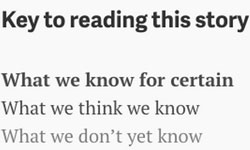As of Sunday night, there remained many unknown elements about the over-the-top subscription service that HBO will launch this year. CEO Richard Plepler confirmed back in October that the premium cable channel would offer the service in 2015. But what would it be called, when would it launch, and on what device(s)?
Quartz writer Adam Epstein wanted to do a story that summarized what was confirmed, likely to be true and as yet unknown about the HBO service. The challenge was to mix information with three different levels of confirmation in a way that readers could understand, while not ruining the flow of the article.
“I had the idea for the piece after browsing Reddit and seeing that despite there being a ton of interest in the upcoming service, there was still some misinformation floating around,” Epstein said by email. “Originally, I wanted to write an all-encompassing guide, but we decided that probably wouldn’t read very well and would quickly become obsolete once the next piece of information trickled in. We knew then that it should be something that could be easily updated.”
News organizations faced with covering an evolving story that offers a mixture of verified and unverified information today often turn to the “What We Know About X” formula. That’s what Variety did after Plepler’s October announcement, for example. Sometimes those articles combine a What We Know section with a related one about What We Don’t Know, as was the case with this Vox story.
More commonly, and as described in detail in my recent research report for the Tow Centre for Digital Journalism, journalists flag unconfirmed items for readers by using hedging language “reportedly” “claimed” and attribution formulations “according to”.
Epstein and Quartz senior editor Zach Seward decided to to try something new. The result is a story that used color shades to communicate information with different levels of confirmation.
Bolded text was fully confirmed. Regular text was used for items that had been reported by what they considered to be reputable sources. Lighter text was used for unconfirmed claims and information.
As with this paragraph:

To help readers process what they were seeing, the story came with a color key at the top:

Along with the key, Epstein also listed all of the sources for his information at the bottom of the story.
“We weren’t really sure how to weave the sources into the text, because the blue URLs would ruin the design,” Epstein said. “So we put them at the end.”
The plan was to update the shading of different parts of the story as new details were confirmed about the HBO service. Epstein didn’t have to wait long: On Monday, HBO’s Plepler was onstage at Apple’s Spring Forward to announce that the service, to be called HBO Now, would debut exclusively on Apple TV.
Here’s a gif showing a screenshot of the lead of the story as it first appeared, and the current text (which has more items in bold):

One question about this new approach is whether readers are able to process what they’re reading and simultaneously apply the color shade information. Do they process the information and the associated visual cue at the same time? The closest research I’m aware of that may apply relates to so-called innuendo headlines. An example of one of this would be: Is HBO’s new over-the-top service launching on Apple TV?
In the case of innuendo headlines, research has found that our brains first process the assertion at the core of the claim. Then we subsequently apply the question mark, which is of course there as a way to suggest that we don’t in fact know the answer. The end result is that readers associate the claim being made with the entity and don’t add much in the way of caveats. Psychologist Daniel H. Wegner outlined the effect in his paper, “Innuendo and Damage to Reputations”:
Information that is conveyed through questions, denials, or even qualifications (e.g., this possibility may not be true) is understood first, and is then cognitively reprocessed and imbued with the internal equivalent of the logical “not.” The “not” qualifier becomes, then, what may be a superfluous addendum to the stored information.
Could text shading be more effective? It would be interesting to study.
For now, what’s positive is that Quartz is trying new formats and approaches for communicating unverified information in a story, and with ways of updating and evolving said story.
The more journalists and news organizations test new ideas, the more likely they’ll develop an approach that can scale and become widely adopted.
“Reality is messy, and we wanted a way to reflect that without encumbering the reader. It’s too early to tell if this format worked,” Seward said. “We’re just experimenting with this one piece for now and will keep it updated as there’s new information.”







Comments